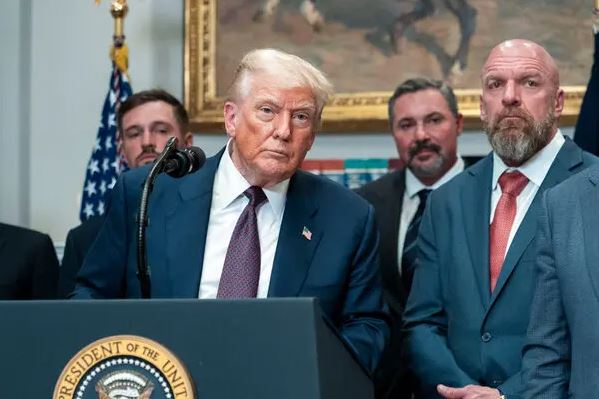Global Trade on Edge as Trump Enforces August 1 Tariff Deadline
In a move poised to redefine international commerce, former President Donald Trump has declared that starting August 1, 2025, the United States will impose massive new tariffs on a wide array of global trading partners. This decision stems from Trump’s push for what he terms “reciprocal tariffs,” a policy that demands other nations match the U.S.’s import and export tax structures or face economic consequences. As the clock ticks down, the global trade community braces for impact.
What Are Reciprocal Tariffs? Understanding Trump’s Economic Playbook
Trump’s tariff strategy revolves around levying duties of 10% to 50% on countries that he argues have unfair trade practices. Under his plan, if a nation taxes U.S. exports at a higher rate than the U.S. taxes theirs, that country will face corrective tariffs to level the playing field. This policy is being enforced under the International Emergency Economic Powers Act (IEEPA), a law granting wide-ranging authority to the executive branch during national emergencies.
According to Trump’s Commerce Secretary Howard Lutnick, these tariffs aim to “protect American industries, jobs, and economic sovereignty.” However, the policy has stirred concern globally, with economists, trade experts, and allied nations warning that the move could disrupt supply chains, inflate prices, and trigger retaliatory measures.
Nations Facing the Heat: Who’s in and Who’s Out?
As the deadline looms, countries fall into three categories:
Countries with Active Trade Agreements
A select few countries have either finalized or are close to finalizing bilateral trade agreements with the United States:
- Vietnam
- United Kingdom
- Turkey
These nations are expected to avoid the brunt of the tariffs, having worked swiftly to align with U.S. trade demands.
Countries Still Negotiating
Several major economic players are in limbo:
- European Union
- Japan
- India
- Canada
- South Korea
- Brazil
Although discussions are underway, these countries have not completed deals. Without finalized agreements by August 1, they could face tariffs ranging from 25% to 50%, depending on the perceived disparity in trade terms.
Countries Without Progress
Smaller economies, such as Cambodia, Lesotho, and others, have not made meaningful progress toward securing exemptions. These nations are likely to experience immediate fallout, including export declines, factory closures, and job losses, particularly in sectors like textiles and agriculture that rely on U.S. demand.
Mexico Gets a Last-Minute Reprieve—But Sparks Controversy
Just one day before the tariffs take effect, Trump announced a 90-day delay for Mexico, citing the country’s cooperation on fentanyl enforcement and border security. This exception, however, has sparked backlash.
Critics accuse Trump of playing political favorites, labeling the maneuver the “TACO doctrine”—a mock acronym for “Tariff Announced, Carve-Out”. This pattern of setting hard deadlines and issuing last-minute waivers is raising doubts about the administration’s consistency and strategic clarity.
Legal Firestorm: Courts Scrutinize Tariff Legality
The legality of Trump’s sweeping tariffs is being actively challenged in multiple federal courts. At the center of the legal firestorm is the question: Did the executive branch overstep its authority under the IEEPA?
Several lawsuits, including V.O.S. Selections, Inc. v. United States, have made their way to the U.S. Court of Appeals, arguing that Trump’s use of emergency powers to reshape global trade violates constitutional boundaries. Should the courts rule against the administration, billions of dollars in tariffs could be subject to refunds or reversal, throwing current trade dynamics into uncertainty.
Economic Consequences: From Factory Floors to Shopping Carts
For American Consumers
Economists predict that consumers will soon feel the impact in the form of higher prices on:
- Electronics
- Clothing
- Automobiles
- Furniture
- Food products
As U.S. importers pay more to bring in foreign goods, those costs will be passed down to households, potentially fueling inflation at a time when economic stability is fragile.
For Global Exporters
The fallout is even more immediate for foreign exporters. Bangladeshi textile firms, South Korean tech suppliers, and Indian pharmaceutical producers face shipment delays, customs detentions, and even order cancellations. Many small- to medium-sized exporters, lacking the flexibility to re-route goods or absorb added costs, are being pushed to the brink.
Strategic Calculations: What Trump Stands to Gain Politically
Trump’s tariff deadline is not just about economics—it’s also a campaign weapon. By reviving a hardline trade stance, Trump appeals to:
- Rust Belt voters eager for job protection
- Populist supporters demanding national economic independence
- Republican lawmakers who support decoupling from China and renegotiating trade terms
With the 2026 midterms on the horizon, the tariff rollout aligns with Trump’s “America First” narrative, allowing him to present himself as the only candidate willing to stand up to foreign powers and protect domestic manufacturing.
Diplomatic Fallout: Allies Frustrated, Adversaries Emboldened
European Union
EU officials have called the policy “discriminatory” and “damaging to decades of diplomatic progress.” Brussels is preparing a set of countermeasures, including possible tariffs on U.S. tech and agricultural products.
India
Facing among the highest potential penalties, India has declared the tariffs “unacceptable and unprovoked.” New Delhi is considering filing a complaint with the World Trade Organization and could curtail military procurement contracts with U.S. defense firms.
China
While already embroiled in a long-standing trade war with the U.S., Beijing sees an opportunity to expand its global influence by offering easier trade terms to countries squeezed out by U.S. policy. China is expected to aggressively court nations in Africa, Southeast Asia, and Latin America, offering new deals to fill the vacuum left by U.S. tariffs.
Conclusion: A High-Stakes Gamble for the Global Economy
Trump’s sweeping new tariffs mark a critical juncture in U.S. trade policy. While the move is designed to assert U.S. economic dominance and secure fairer deals, the risk of global retaliation, legal reversals, and consumer backlash looms large.
As nations scramble to respond, businesses brace for turbulence, and legal experts challenge executive authority, the world watches closely. August 1 may not just be a deadline—it may be the beginning of a new era of protectionism, reshaping trade for years to come.
Keywords: Trump tariffs August 1, reciprocal tariff policy, Trump trade war 2025, U.S. global tariffs, Trump economic policy, IEEPA trade authority, U.S. bilateral trade agreements, tariff deadline 2025, Mexico tariff exemption, global trade disruption.

